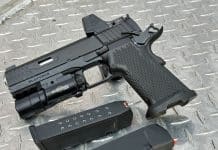The M60 Has Been Rocking Battlefields Since 1957
The M60 is the iconic machine gun for big budget films and battlefields around the world.
The M60, officially the United States Machine Gun, Caliber 7.62 mm, M60, is a family of American general-purpose machine guns firing 7.62×51mm NATO cartridges from a disintegrating belt of M13 links. There are several types of live ammunition approved for use in the M60, including ball, tracer, and armor-piercing rounds.
Introduced in 1957, it has served with every branch of the U.S. military and still serves with other armed forces. Its manufacture and continued upgrade for military and commercial purchase continues into the 21st century, though it has been replaced or supplemented in most roles by other designs, notably the M240 in U.S. service.
Specifications
- Weight:23.15 lb
- Length: 43.5 in
- Barrel Length: 22.0 in
- Cartridge: 7.62×51mm NATO
- Caliber: 7.62 mm (0.308 in)
- Action: Gas-operated, short stroke gas piston
- Rate of Fire: 500–650 rounds/min
- Muzzle Velocity: 2,800 ft/sec
- Effective Firing Range: 1,200 yd
- Feed System: Disintegrating belt with M13 Links
- Sights: Iron sights
History
The M60 machine gun began development in the late 1940s as a program for a new, lighter 7.62 mm machine gun. It was partly derived from German guns of World War II (most notably the FG 42 and the MG 42), but it contained American innovations as well. Early prototypes, notably the T52 and T161 bore a close resemblance to both the M1941 Johnson machine gun and the FG 42. The final evaluation version was designated the T161E3. It was intended to replace the M1918 Browning Automatic Rifle and M1919A6 Browning machine gun in the squad automatic weapon role, and in the medium machine gun role. One of the weapons tested against it during its procurement process was the FN MAG.
The U.S. Army officially adopted the T161E3 as the M60 in 1957. The decision to adopt the M60 instead of foreign designs, like modified versions of the proven German MG42 or the still-unproven FN MAG, was largely due to strict Congressional restrictions requiring preference be given to the designs of US arms manufacturers (even if a superior design was available from foreign sources) primarily out of desire to avoid paying licensing fees, but also out of a strong bias in favor of domestic products.
The M60 later served in the Vietnam War as a squad automatic weapon with many U.S. units. Every soldier in the rifle squad would carry an additional 200 linked rounds of ammunition for the M60, a spare barrel, or both. The up-gunned M113 armored personnel carrier ACAV added two M60 gunners beside the main .50 caliber machine gun, and the Patrol Boat, River had one in addition to two .50 cal mounts.
During the Vietnam War, the M60 received the nickname "The Pig" due to its bulky size.[7] Vietnam’s tropical climate harshly affected weapons, and the M60 was no exception. Its light weight made the gun damage easily and critical parts like the bolt and op rod wore out quickly. Even so, soldiers appreciated the gun’s handling, mechanical simplicity, and effective operation from a variety of firing positions. Navy SEALs used M60s with shorter barrels and no front sights to reduce weight further. Some SEALs had feed chutes from backpacks to have a belt of thousands of rounds ready to fire without needing to reload.
In the 1980s, the M60 was partially replaced by the M249 Squad Automatic Weapon within Army infantry squads. Their new doctrine with the weapon reduced the general purpose machine gun role in favor of portability and a greater volume of fire. Soldiers disliked the new strategy, as even though the lighter SAW made movement faster, in firefights the larger 7.62 mm round is preferred. In defensive roles, the M60 has better accuracy and a longer range to keep the enemy back. The M60 was retained in the vehicle mounted role and the general-purpose role due to its greater power and range compared to the 5.56 mm M249.
In U.S. Marine Corps service, concerns about the M60’s reliability, weight, and the high round counts of many M60s in service prompted the adoption of the M60E3 to replace most original M60s in infantry units. The M60E3 was five pounds lighter than the original M60. It included a forward pistol grip and had the bipod mounted to the receiver rather than the barrel. The weapon still was not durable and its performance was reduced.
In the early 1990s, Saco addressed Navy Special Warfare requirements to develop a retrofit parts package for the machine gun. Called the M60E4, it was more reliable and durable than the M60E3, had a "duckbill" flash suppressor, and a shorter and thicker positive lock gas cylinder extension. NAVSPECWAR units began to receive it in late 1994, when it was designated the MK43 Mod 0.
In January 1994, the U.S. Army began the Medium Machine Gun Upgrade Kit program. The only two competitors were M60 and M240 versions. Saco offered an "enhanced" M60E3 with product improved parts and FN offered its M240 coaxial gun with a buttstock, bipod, and other infantry features. As such, both weapons were upgrade kits of weapons already in service. 18 guns of each were tested until December 1995. There were two main performance areas: Mean Rounds Between Stoppages (MRBS-jams) and Mean Rounds Between Failures (MRBF-parts breaking). 50,000 rounds were fired through both guns. The M60 had 846 MRBS and 1,669 MRBF, compared to the M240’s 2,962 MRBS and 6,442 MRBF. As a result, the M240 was declared the winner and accepted into infantry service. Although the M60 was lighter, had better balance, was more controllable, and there were many in the inventory, it did not work reliably enough.
Starting with Ranger Battalions, the U.S. Army began adopting and modifying M240 variants to replace their remaining M60s in the early 1990s. The M240 is several pounds heavier than the M60, and has a longer barrel and overall length, but it is more reliable in use and testing. However, the M60 uses a much simpler gas system that is easier to clean when care is taken during reassembly. This advantage is obviated since the gas tube is wired shut with lockwire to prevent the weapon from disassembling itself from vibration in hard use.
The M60 continues to be used in the 21st century by U.S. Navy SEALs and as a door gun on U.S. Army helicopters. It was the main 7.62 mm machine gun by some U.S. special operations forces to the late 1990s. As of 2005, it is used by the U.S. Coast Guard, U.S. Navy, and some reserve units. The M60 is generally being phased out.
Pop Culture
Rambo II

Breaking Bad

* The views and opinions expressed on this web site are solely those of the original authors and contributors. These views and opinions do not necessarily represent those of Guns & Tactics Magazine,
the administrative staff, and/or any/all contributors to this site.












